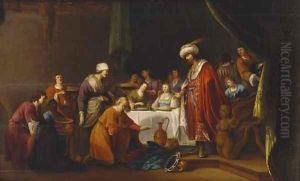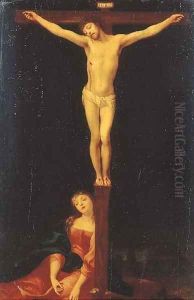Nicolaes Moeyaert Paintings
Nicolaes Moeyaert, also known as Claes Moeyaert and by various other spellings, was a Dutch Golden Age painter and etcher. Born in Amsterdam in 1591, Moeyaert was a prominent figure in the Dutch art scene of the 17th century. Despite not being as widely recognized today as some of his contemporaries, Moeyaert's work was influential during his lifetime, and he left behind a body of art that offers insight into the cultural and aesthetic values of his era.
Moeyaert initially trained under the painter Pieter Lastman, who was also Rembrandt’s teacher. This connection places Moeyaert within a network of artists who were central to the development of a distinctly Dutch style of painting. His early work reflects the influence of Lastman, with a strong focus on historical and biblical scenes characterized by dramatic lighting and rich color palettes.
Over time, Moeyaert developed his own style, which incorporated elements of Flemish Baroque, as seen in the work of Peter Paul Rubens, with a more subdued Dutch sensibility. He was particularly known for his landscape paintings and pastoral scenes, as well as his depictions of mythological and allegorical subjects. His works often featured elegant figures and demonstrated his skillful use of chiaroscuro and atmospheric perspective.
In addition to his paintings, Moeyaert produced a number of etchings that further demonstrate his versatility as an artist. He was active in the Amsterdam Guild of St. Luke and was a respected artist in his time, with his works being sought after by collectors and patrons.
Moeyaert's influence extended to his pupils, who included notable artists such as Jacob Backer, Jan van Noordt, and Pieter de Grebber. Through his teaching and his art, he played a role in shaping the direction of Dutch painting in the 17th century. Moeyaert died in 1655 in Amsterdam, leaving a legacy that, while somewhat overshadowed by the more famous figures of the Dutch Golden Age, remains an important part of the period's artistic heritage.

